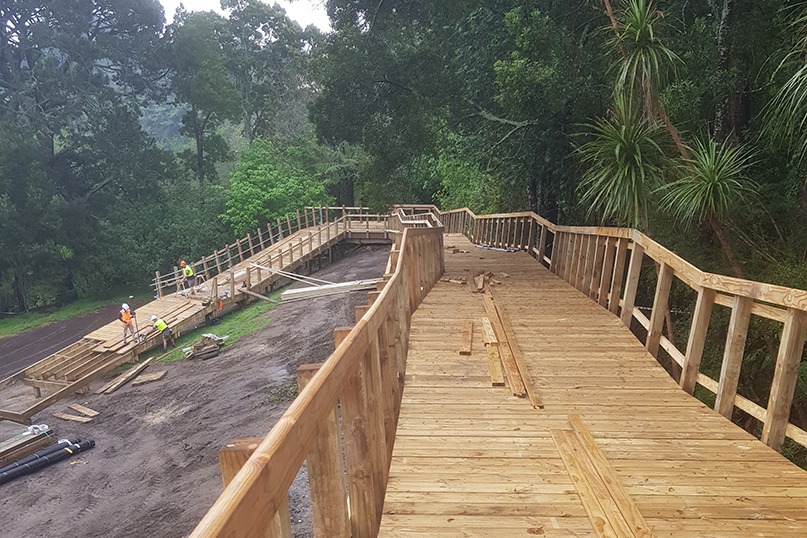
Nestled deep in the south-east corner of Hamilton, works on the final section of the Cambridge to Hamilton Te Awa Shared Path continue to roll on despite the challenges of COVID-19.
Once complete, the 2km Hamilton section that dips and dives along the banks of the Waikato River from the Mangaonua Stream to Hammond Park will not only tie together the entire 60km river path, but will also showcase one of Hamilton’s bustling gully systems – the Mangaonua Gully.
Broken up into three sections, the works involve building 1.15km of new pathway, connecting the existing boardwalk through Hammond Park, as well as completing safety improvements and footpath upgrades along Howell Avenue and Geoffrey Place.
Hamilton City Council Capital Projects Manager, Chris Barton said that the environment has always been a key priority, with climate change and carbon emissions guiding and influencing the design and construction phases of the project – including where the path goes, and the materials used to build it.
The design aims to minimise impact on the gully by retaining as many of the existing trees as possible, and using low carbon engineering solutions such as timber boardwalk, timber pole walls and soil nailing solutions.
“All significant trees in the area were surveyed and ranked by an ecologist during the design phase and the path was re-routed around them to minimise the extent of tree removal.”
The project also involves partnering with Waikato District Council to build a 32m long bridge over the Mangaonua Stream, joining the Hamilton section to the Waikato section of the shared path.
“The bridge has been developed as a low-carbon solution which uses glued laminated timber (glulam) for its structural elements. Once complete, it will be the largest glulam truss bridge in New Zealand.”
Staff have also been keeping a close eye on the gully’s current tenants: the native, and now award-winning, long-tailed bat (pekapeka-tou-roa), factoring their protection into project decisions.
Council has a special relationship with the critically threatened species, which took out New Zealand’s famous Bird of the Year competition for 2021. With support from Waka Kotahi NZ Transport Agency, Council has continued to monitor their behaviour as part of projects like the Southern Links transport network in Peacocke, and this shared path project in the Riverlea area.
“Because of this, we’ll also be installing bat boxes (artificial roosts), pest control and weed control as part of the project,” said Barton.
Along with retaining existing trees, Council is funding 1700 new plants as part of the project, while Waikato Regional Council will be planting an additional 3800 plants in the Mangaonua Gully.
A regular path user herself, Infrastructure Operations Committee Chair, Councillor Angela O’Leary said she can’t wait to get on the bike and connect with our neighbours across the region.
“As part of Council’s vision, we want Hamilton to be a 20-minute city where people can get from one neighbourhood to the next easily, no matter how they choose to travel. It’s also important that we provide connections in and out of Hamilton so our residents can experience all that the Waikato has to offer – the Te Awa shared path absolutely helps deliver this goal,” said Councillor O’Leary.
“Looking after our environment and providing facilities so our people can choose low-carbon active transport options go hand-hand when it comes to the well-being of Hamiltonians. I’m really happy that this project ticks both boxes by providing an awesome, people-friendly path, constructed in an eco-friendly way, that we can all enjoy.”
Council is working with other partners involved in the Te Awa Shared Path to plan an opening event for 2022. This event will celebrate the completion of the last section of the path, which expects to see up to 225 people each day biking, scootering and walking along its length.
